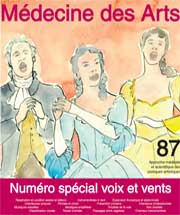The life of professional singers unfolds under a myriad of risk factors likely to affect their voice. The purpose of this study was to meet with professional singers of popular amplified music in order to draw up a detailed profile and determine the vocal implications specific to this population. The first hypothesis concerned their poor management of risky practices. Semi-directed interviews were conducted with 73 contractual on-stage singers in France. Their degree of exposure to vocal risks proved to be substantial, and included speaking-voice overuse, strenuous tour schedules, a haphazard lifestyle, and a level of vocal strain which, for some, revealed a pre-lesion condition.
Above all, this study shed light on the great diversity of practices in the field of popular amplified music (training and education, performance conditions, number of concerts, etc.). Vocal strain does not seem to be affected by the pace of stage performances or the amount of education. What's more, an analysis of the subjects’ knowledge of the voice pointed out that they underestimated the consequences of long-term vocal difficulties, differed in their knowledge levels depending on how long they had been performing, and had a better mastery of vocal functioning and voice hygiene rules than they did of voice disorders.
Another finding for this type of professional singer was the need for prevention programs that take into account the specificities of their artistic practices. Most of these singers have already made empirical attempts to cope with certain vocal difficulties. The second hypothesis of this study – that professional singers of popular amplified music are demanding such tools themselves – was also validated. The study confirmed the utility, in particular for voice therapists, of setting up prevention programs geared specifically to treating voice disorders among professional singers of popular amplified music.
Key words: prevention; voice disorder; professional singer; risk factor; popular music; amplified music.

